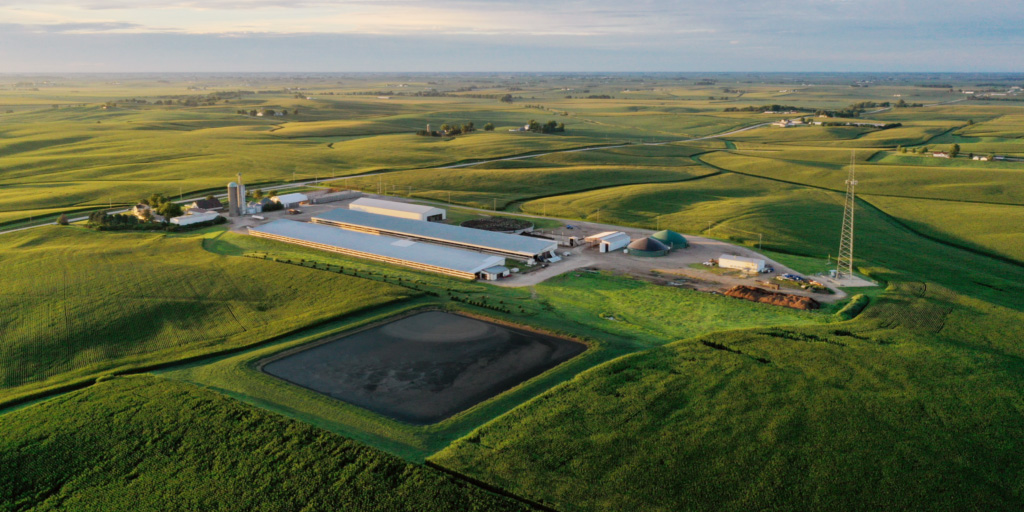
A bird’s eye view of Sievers family farm in Scott County, including cattle barns and anaerobic digesters. (Photo: 4R Plus)
Digesters, bioenergy and conservation bonanza
April 4, 2023
The Iowa Soybean Association (ISA), the Iowa Agriculture Water Alliance (IAWA), and others are pursuing yet another way cover crops could benefit farmers by selling harvested cover crops to produce renewable natural gas, electricity and biofertilizer.
“While this technology has been deployed in Europe, China and elsewhere for decades, one reason it hasn’t taken off in the U.S. is that the right environmental markets didn’t exist,” says Matt Herman, ISA senior director of renewable products marketing.
Work is progressing on efforts to develop and promote digesters that can convert cover crops, crop residues, prairie grasses and livestock manure to sustainable energy and fertilizer.
“With recent changes to the Renewable Fuel Standard from the Environmental Protection Agency (EPA) and funding from the U.S. Department of Agriculture’s (USDA) Climate Smart Commodities program, we aim to prove it can work here, too,” Herman says.
Potential benefits
A new $80 million USDA grant will help fund the greater deployment of cover crops to be co-digested with hog manure.
The five-year grant, Horizon II, is among 70 projects in the USDA’s Partnerships for Climate-Smart Commodities program. Roeslein Alternative Energy from St. Louis is leading the project.
More than half of the grant dollars, expected to be awarded soon, will go toward creating a new market for prairie grasses and cover crops like cereal rye. The plan is to pay corn and soybean producers in Iowa and Missouri to plant and harvest winter-hardy crops. Farmers will also receive money to restore low-yield areas to prairies.
“It’s creating a renewable fuel while simultaneously improving water quality by having living roots in the ground, preventing erosion, improving soil health and adding pollinator habitats,” says IAWA Communications Director Rebekah Jones.
As part of the project, two pilot sites will be established where harvested grasses and cover crops will be used as feedstock for anaerobic digesters. The digesters produce methane as microbes break down organic matter. One site is located near Stockton on the Sievers Family Farm, a 2,400-head cattle operation.
On their eastern Iowa farm, the Sievers have been converting manure and bedding into biogas for nearly 10 years. In 2021, the family entered into an agreement with Roeslein to create renewable natural gas.

Expanding opportunities
Herman says co-digesting cover crops also could help bring digesters to hog farms.
“Generally speaking, digesters can use any kind of manure,” he says. “But cattle and dairy manure has been preferable due to its composition and high-production volume per head of livestock.”
Cover crop biomass could be blended with hog manure, providing a more balanced diet for the microbes.
The benefits of this system are immense, Herman and Jones say, because it creates sustainable energy and helps manage nutrients, a major priority for Iowa.
“This project is unique because it intentionally targets the use of cover crops, which historically have no market,” says Herman. “We see the ability to create demand for a commodity (cover crops), which we know has significant environmental benefits.”
Supporting the effort
Typically, farmers chemically terminate their cover crops before planting soybeans or corn. In this project, farmers aim to discover if harvesting cover crops instead of terminating them will yield the same soil health benefits.
IAWA is communicating the opportunity to farmers growing cover crops.
“We’re thrilled to promote this opportunity,” Jones says. “Growing cover crops is one way that helps reach our water quality goals.”
IAWA, ISA and other partners are working through the paperwork and anticipate beginning the project in earnest in the next several months.
“We need to be cheerleading and pushing forward,” Herman says. “This project has major implications for soybeans. Creating a valueadded market that incentivizes greater growth of cover crops would be crucial, as cover crops are one of the best ways to reduce the current carbon intensity of soybean oil-based biodiesel.”
The No. 1 takeaway
“At the end of the day, we still have a lot to learn,” Herman concedes. “What will the next five years look like? Maybe there’s a handful of digesters/co-ops, but we won’t be at the scale of corn ethanol and soy biodiesel.”
Herman says various entities, such as the American Biogas Council, believe that converting cover crops to sustainable energy and fertilizer, as well as expanding new economic markets for Iowa farmers, is part of the future.
“We believe this could be an important value-added market, one which has the potential to make cover crops a profitable part of the rotation,” Herman says. “That’s the No. 1 takeaway.”
Back